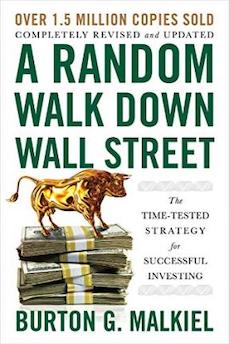 A popular investing book that I received for speaking about my trading at a live event. The book was first published in 1973 but has been revised and updated several times. This one is the latest twelfth edition published in 2019. The author is an academician who supports passive index investing, and his content represents the opposite view to what I do myself in the stock market, that is trading based on price action. Still I find it educative to learn different views to better understand why I do what I do.
A popular investing book that I received for speaking about my trading at a live event. The book was first published in 1973 but has been revised and updated several times. This one is the latest twelfth edition published in 2019. The author is an academician who supports passive index investing, and his content represents the opposite view to what I do myself in the stock market, that is trading based on price action. Still I find it educative to learn different views to better understand why I do what I do.
Fundamentals nor technicals won’t remove the randomness
In the first part there’s introduction to stocks and investing. Malkiel describes what he believes to be the random walk of markets, and I don’t disagree with him on the fact that markets behave randomly even though I use technical analysis to trade stocks. My technical analysis is not predictive but reactive instead, so I’m fine with random price moves because I cut losers and keep winners. I’m not trying to be right. He writes about Firm-Foundation Theory that studies companies’ intrinsic value, and Castle-in-the-Air Theory that applies technicals to buy stocks to sell it later to a “greater fool” at higher prices. I can classify my momentum, swing and trend strategies to the latter approach.
Bubbles prove the markets are irrational
Furthermore, Malkiel writes about the madness of crowds describing the speculative market bubbles in history. The human nature doesn’t change, history keeps repeating itself and new bubbles will always occur. Just like companies were bought up in late ’90s because they added “Internet”, “dot com” or something similar to their name, random companies skyrocketed in price in 2017-18 after they had added “blockchain” to their name in the midst of the crypto bubble. It’s interesting to note that even if the author tries to make his point about efficient markets, his introduction to all the market bubbles can make the reader actually think how irrational the markets can be.
Don’t try to predict the future
In part two, the author gets technical analysis almost right, but he classifies all chartists as people who are constantly trying to predict the future. I don’t try to predict anything with TA, it’s all about probabilities and reacting to the price. However, I don’t mind his view on this. There is no right or wrong in the markets, just millions of opinions from market participants. Malkiel writes he has never met any successful technician which means he’s just been around other people than chartists. He should read the five books of Market Wizards series for the start to find out about successful technicians every aspiring trader would like to meet. At least he admits that fundamental analysis can be just as random as technical analysis which also holds true in my opinion. If things weren’t random I wouldn’t use stops to realize small losses. Malkiel doesn’t believe anyone could have consistent success analyzing fundamentals and beat the stock market benchmark. He suggests that buying and holding a passive index fund is the best way to go. Average annual return of 10% for the risk of 50% drawdowns? No, thank you!
Volatility and risk
Part three describes the Modern Portfolio Theory by Harry Markowitz. It shows how diversifying investments to more risky but less correlated markets can decrease the overall risk but offer better return. I don’t share the view that volatility means risk. Risk is the possibility of losing money, volatility creates opportunities. More volatility isn’t necessarily a bad thing if it exploits a positive expectancy with measured risk.
Passive investing for average return
In the last fourth part Malkiel shows historic data of stocks and bonds. He gives some practical advice on constructing one’s investing portfolio depending on age, job and other life factors. The author shares specific ETFs to choose from. The main message here is to invest money in passive index funds for the market average return because most won’t beat the benchmark anyway. I think it’s reasonable advice to people who don’t want to have anything to do with the markets and only add capital regularly to save for retirement. Personally, I could not wake up and say to myself that I want to be average. I like the challenge of trading and I want to grow as a person together with my trading account.
Summing it up
It’s interesting that even such an experienced person like Burton Malkiel shares conventional misconception thinking stock traders need to be right, TA can’t successfully predict the future and therefore it’s not more reliable than a coin toss. Well, predicting the future is not what many traders do. Secondly, give me a 50% win rate with wins considerably larger than losses on average and I’ll throw my money at it anytime. Traders don’t need to be right often to make money in the long run, winners need to pay for the losers. If you don’t want to trade nor manage your stock portfolio, but to save for retirement instead, then this book is a guide for you on how to passively do it.
A Random Walk Down Wall Street by Burton G. Malkiel book link
Share this post